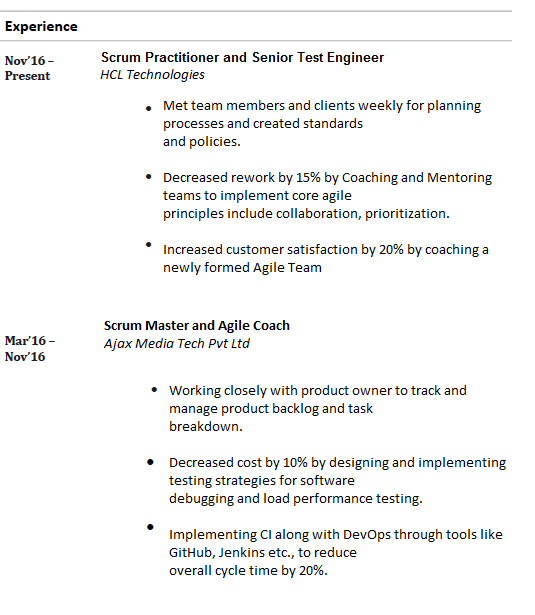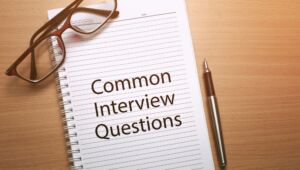A resume comprised of several required sections including your contact information, work experience, Skills, and education. The most important area for which recruiters are mainly concerned is your work experience in your resume. Work experience is an essential component of a resume, as it provides potential employers with a clear understanding of the candidate’s skills, abilities, and professional history.
Make sure your work experience section is clear, concise, and demonstrates your skills and achievements. This will help your resume stand out to potential employers and increase your chances of landing an interview.
People have strong relevant work experience but fail to express to impress the recruiter. Here are complete tips about how to add work experience to a resume.
Resume Format
Before you begin adding your work experience, it’s important to choose the right resume format. There are basically three types of resume formats which are
The chronological Format mainly highlights your work experience in your resume. It is the most common and best way to lay out your work experience. In this format, your work experience is in reverse order after the object or introduction. Which means the most recent or current experience comes first.
The chronological Format is preferred by most recruiters because they mainly concern with your recent or current experience. Have look at the example below to understand better.
Here’s an example of how to organize your work experience section using the chronological format:
Work Experience
Job Title, Company Name Location Dates of Employment
- Bullet point describing your responsibilities and achievements in the role
Job Title, Company Name Location Dates of Employment
- Bullet point describing your responsibilities and achievements in the role
Job Title, Company Name Location Dates of Employment
- Bullet point describing your responsibilities and achievements in the role
Experience under chronological format

Using the chronological format allows employers to see your most recent work experience first, which is often the most relevant and important for the position you’re applying for. It also provides a clear and easy-to-follow timeline of your career progression.
However, if you have gaps in your employment history or have worked in different fields or industries, the chronological format may not be the best fit for your resume. In this case, you may want to consider using a functional or combination format instead.
Also Read: How to select the Best resume format?
Describe Your work Experience in 2-5 Bullet Points
Employers typically have limited time to review resumes, so limiting to 2-5 bullet points makes it easier for them to quickly identify your relevant experience. By limiting the number of bullet points, you also ensure that you are only including the most relevant and impressive information. This can prevent your resume from becoming too long or cluttered, which can turn off potential employers
Don’t write about every task you’ve performed, filtered the best of them and describe your experience in a maximum of 5 points. Make points short and relevant to present your experience in a powerful manner.
Example
- Motivated and guided the sales team to exceed monthly sales goals by 15%.
- Achieved about 90% customer satisfaction by resolving customer queries and complaints.
- Improved sales performance by developing sales metrics and training programs.
Key Achievement
- Achieved more than 150% of the target in 2 consecutive years.
Overall, using 2-5 bullet points to describe your work experience can help you to create a clear, concise, and impactful resume that highlights your qualifications and sets you apart from other candidates
Mention Job Title and Company Name
Do mention your job title and name of the company at the top under the experience of each company. It makes your resume more compelling to the recruiter. This information provides context to the reader and helps them to understand your level of experience and the types of organizations you have worked for.
Example
Human Resource Manager,
Harman Connected Services
Limit Your Recent Experience Up to 15 Years
Obviously, the single-page resume has an advantage over two pages resume. So try to limit your resume to a single page. Whereas two pages are OK for the more experienced candidate but more than two pages are not recommended.
If you have 25 years of experience and you add all of them it will make your resume very lengthy and boring. So it is recommended not to mention your experience of more than 15 years.
Limiting your recent experience up to 15 years in a resume is a common practice for several reasons:
- Relevance: A resume should focus on the most relevant and recent experience that demonstrates your skills and qualifications for the job you are applying for. Including experience beyond 15 years may not be as relevant or significant to the employer, as technology and industry standards may have changed.
- Space: A resume should be concise and easy to read, and limiting your experience to the most recent 15 years can help you avoid cluttering your resume with irrelevant information, allowing you to focus on your most recent accomplishments.
- Ageism: Unfortunately, age discrimination is a real concern for job seekers. By limiting your experience to the most recent 15 years, you can avoid revealing your age and potentially being passed over for a job due to age bias.
However, there may be exceptions to this rule. For example, if you have significant experience in a particular field that goes beyond 15 years and is relevant to the job you are applying for, you may want to include it in your resume. Additionally, if you have had a long tenure with a particular employer, it may be appropriate to include your full work history with that employer to demonstrate your loyalty and commitment.
Highlight Your Achievement, Responsibilities, and Skills
Recruiter is mainly concerned with your accomplishment and skills that you developed in previous or current work. Adding some figures as achievements will increase the chance of resume selection.
List your previous job achievement, responsibilities, and skills using bullet points to break them down into specific tasks and duties. Make sure they are relevant to the job you are applying for and highlight those that demonstrate your experience and expertise in the field.
But do not provide any information which is not true or that you can’t offer to your future employer. Here are some examples that help you to understand better.
Example
- Decreased rework by 15% by Coaching and Mentoring teams to implement core agile principles including collaboration, and prioritization.
- Implementing CI along with DevOps through tools like GitHub, Jenkins, etc., to reduce overall cycle time by 20%.
- Implementing CI along with DevOps through tools like GitHub, Jenkins, etc, to reduce overall cycle time by 20%.
Don’t Add Irrelevant Details
One of the biggest misconceptions among people is that they think more responsibilities and skills they mention, the chances of getting an interview call will be high. But it is not the case, if you are applying for an electrical engineer profile and you mention your programming skill, it is just impractical from the recruiter’s point of view.
It’s important not to add irrelevant details to your resume, as this can distract from your qualifications and make it harder for potential employers to see your strengths. Only your relevant experience works for you and adding irrelevant experience only kill your space in a resume.
Also Read: 12 Effective Resume Writing Tips For Professional Resume Writing
Remember to tailor your resume to the specific job you are applying for and focus on the achievements, responsibilities, and skills that are most relevant to that role. Keep your language concise and straightforward, and use bullet points to make your resume easy to scan quickly. Finally, proofread your resume carefully to ensure that it is error-free and presents you in the best possible light.
![You are currently viewing How to Add Work Experience in Resume [Examples]](https://ziapy.com/wp-content/uploads/2018/12/pexels-photo-842554-e1580026025583.jpeg)





